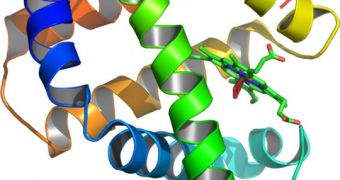A team of experts from the Scripps Research Institute was recently able to devise a new method of producing advanced, super protein killers. Their technique is fairly simple, as it relies on shining a special beam of light over specific molecules. This turns these agents, that are otherwise only modestly-effective in destroying proteins, into super-killers, capable of taking out their targets with maximum efficiency. The new method could in the near-future be used in a large array of research fields, aimed at developing new cures and treatments for many disorders, PhysOrg reports.
Basically, in the new approach, “warhead” molecules are driven near the targeted proteins, whereupon they are detonated using a novel light-activation technology. Details of the team's accomplishments appear in the March 14 advanced online issue of the esteemed scientific publication Nature Chemical Biology. “High-throughput screening can produce a synthetic ligand [peptoid] capable of binding to just about any protein you want,” explains SRI Department of Chemistry professor Thomas Kodadek.
“The problem is, they almost always have modest potency – which makes them less than ideal research tools. By attaching this 'warhead' molecule to a peptoid, we've shown that we can increase that protein-killing potency by a thousand fold without going through an expensive and time-consuming optimization process,” adds Kodadek, who was also the leader of the new investigation. He argues that, with the help of some specific, light-activated agents in the warhead molecule, the researchers could easily learn how to knock out certain protein functions.
This could, in turn, have significant implications for fields of research such as treating cancer, where preventing proteins in tumor cells from going about their daily business could mean the difference between life and death for the patient. But the Scripps team says that their light-activation technique is precise enough to allow for researchers to, for example, knock out protein functions in only a single part of a fully-developed cell, which means that the “tailoring” possibilities could be never-ending. The new activation technique is called CALL, which stands for chromophore-assisted light inactivation.
“When we first had this idea to collaborate to identify hundreds of protein ligands simultaneously, my enthusiasm was diminished by the fact that I knew they would all be modest potency compounds and the numbers would overwhelm our ability to optimize them all by traditional means. Our new 'warhead' technique solves that problem,” adds Kodadek.

 14 DAY TRIAL //
14 DAY TRIAL //